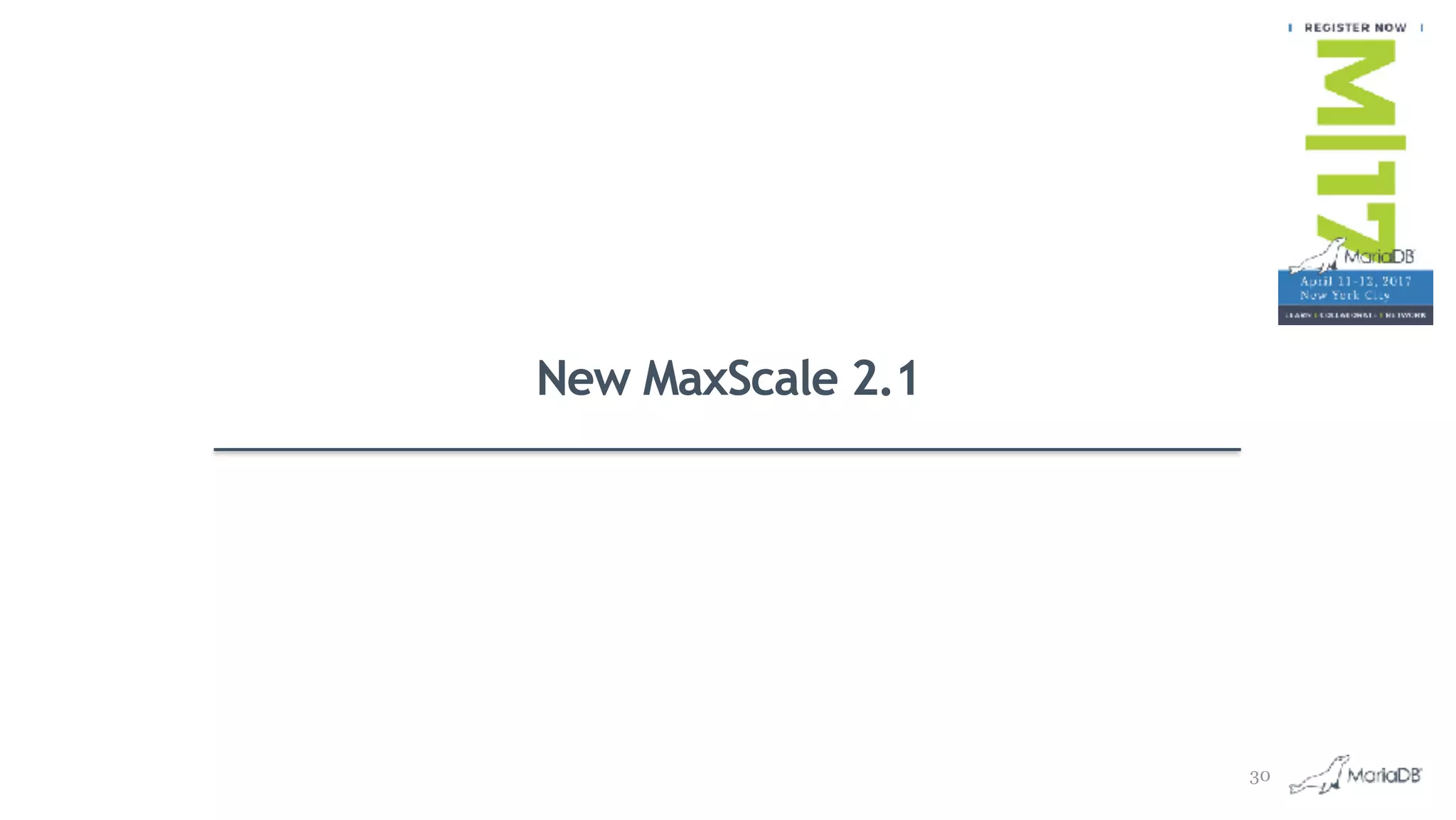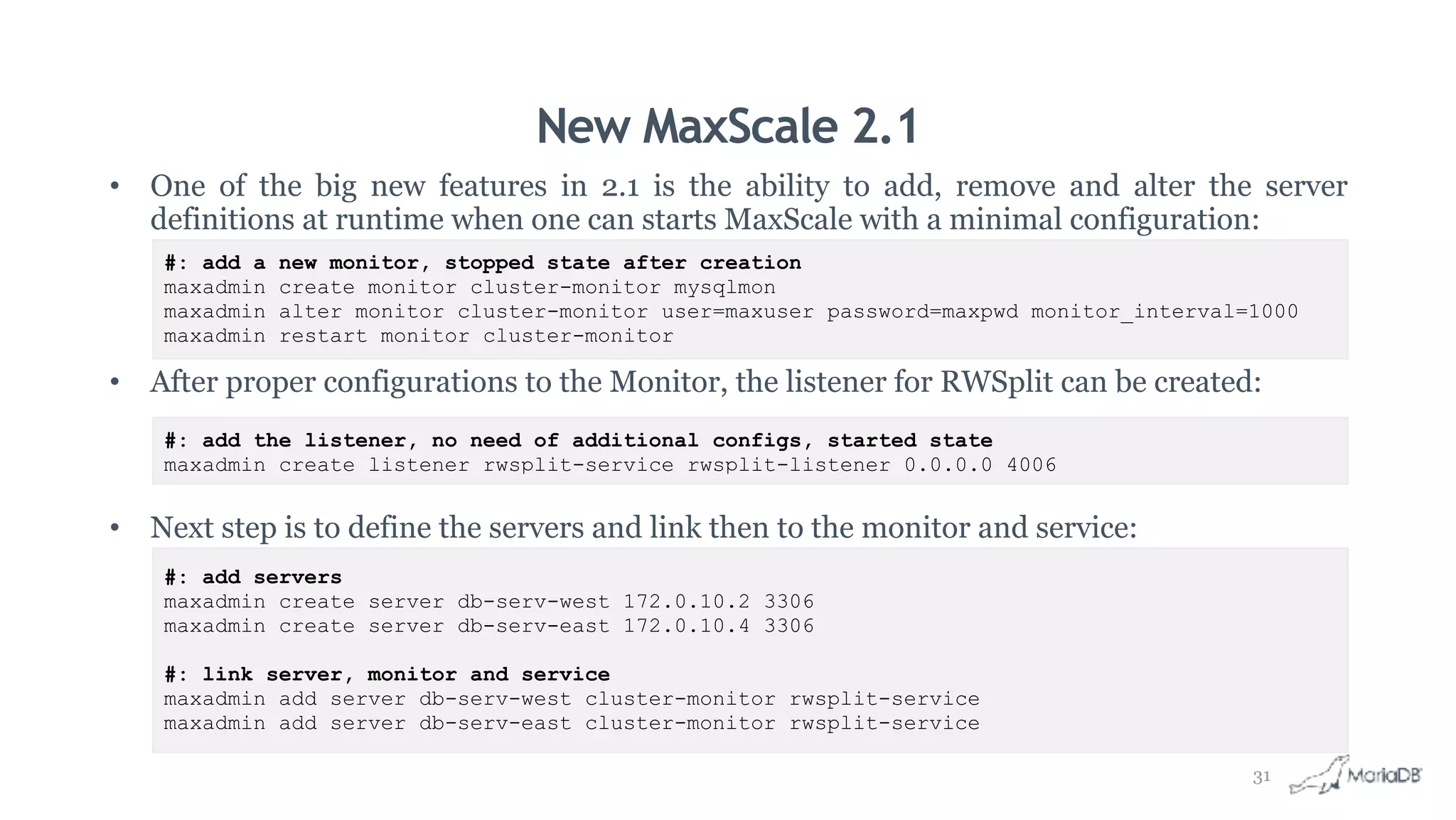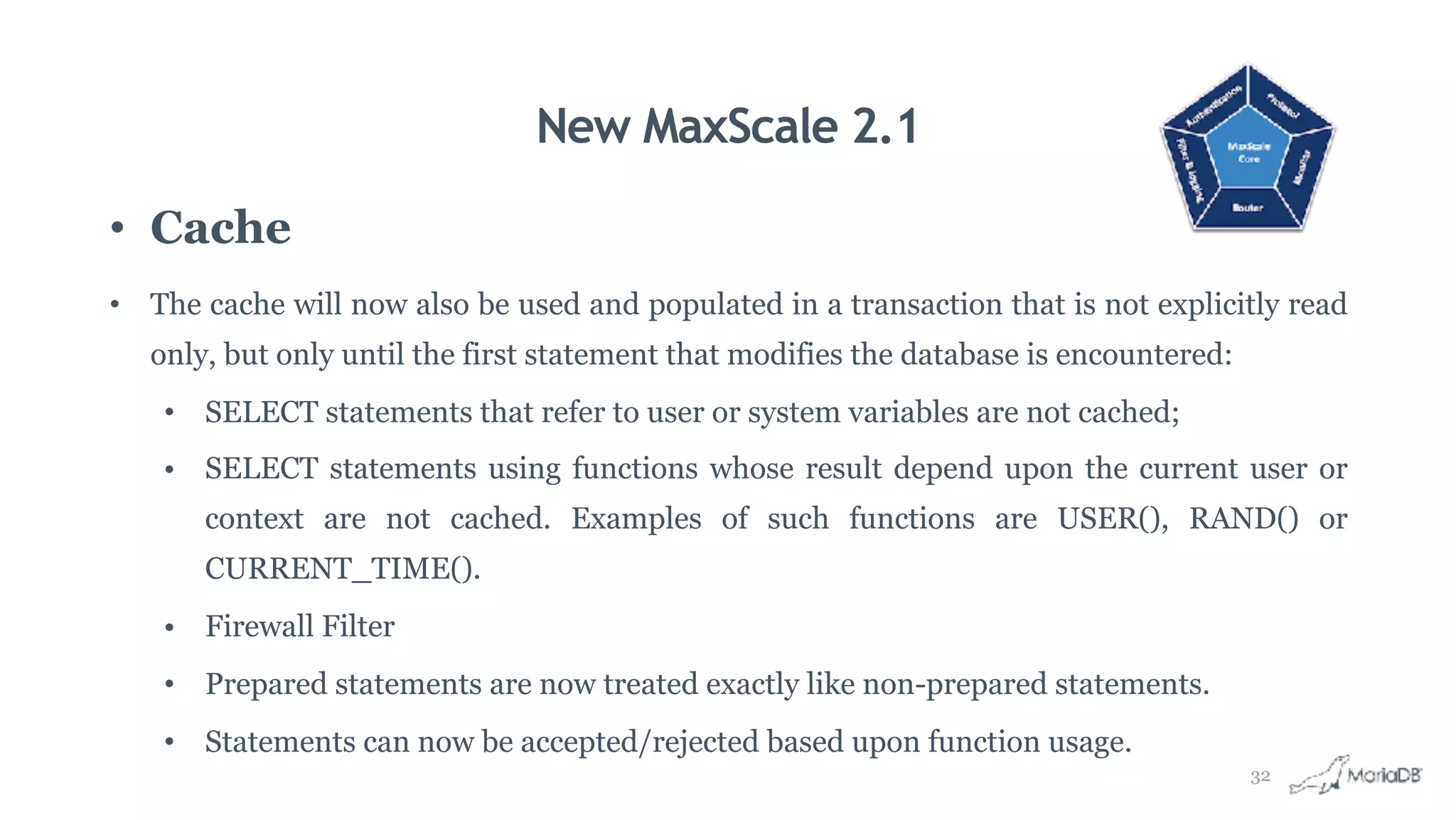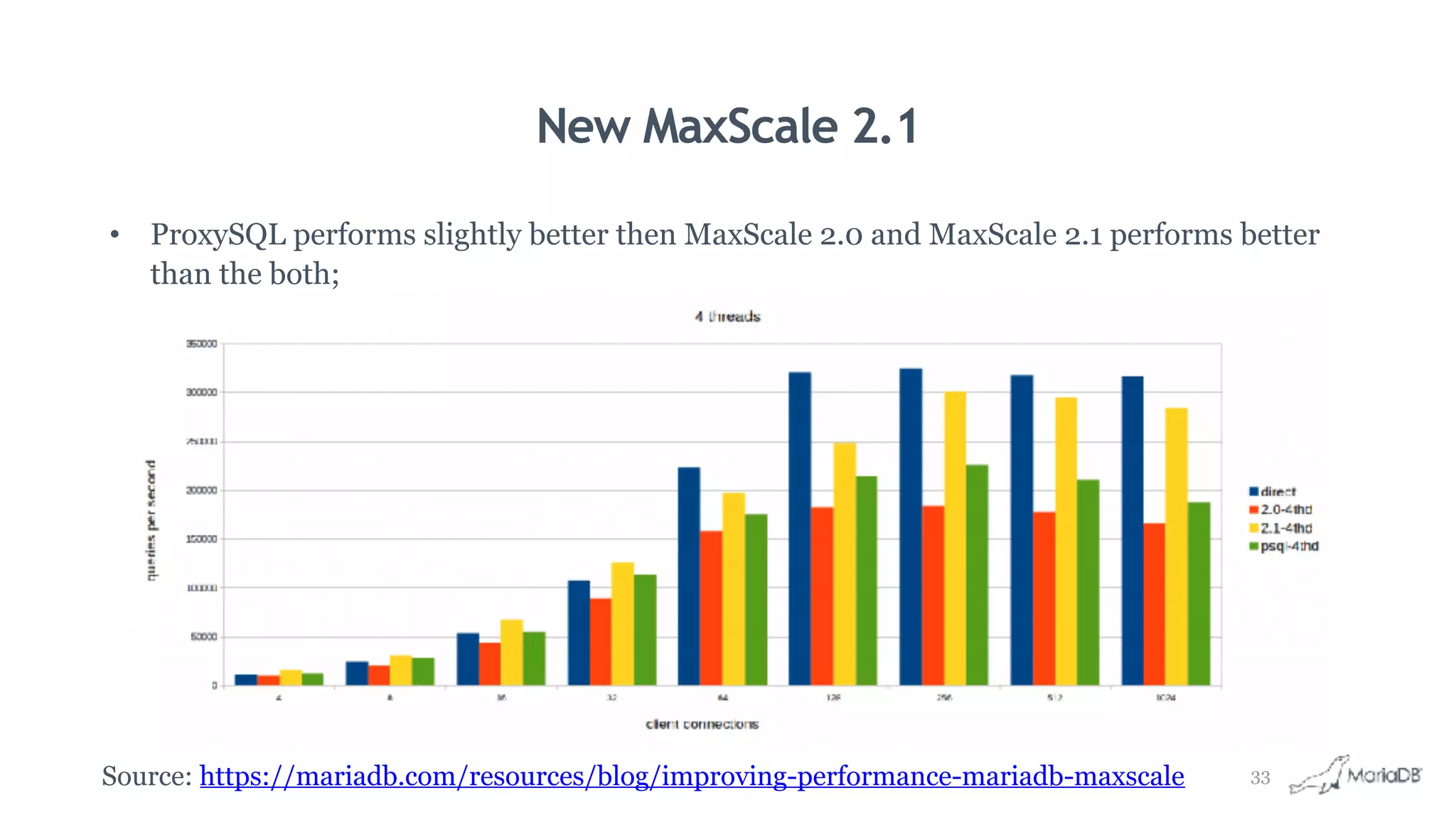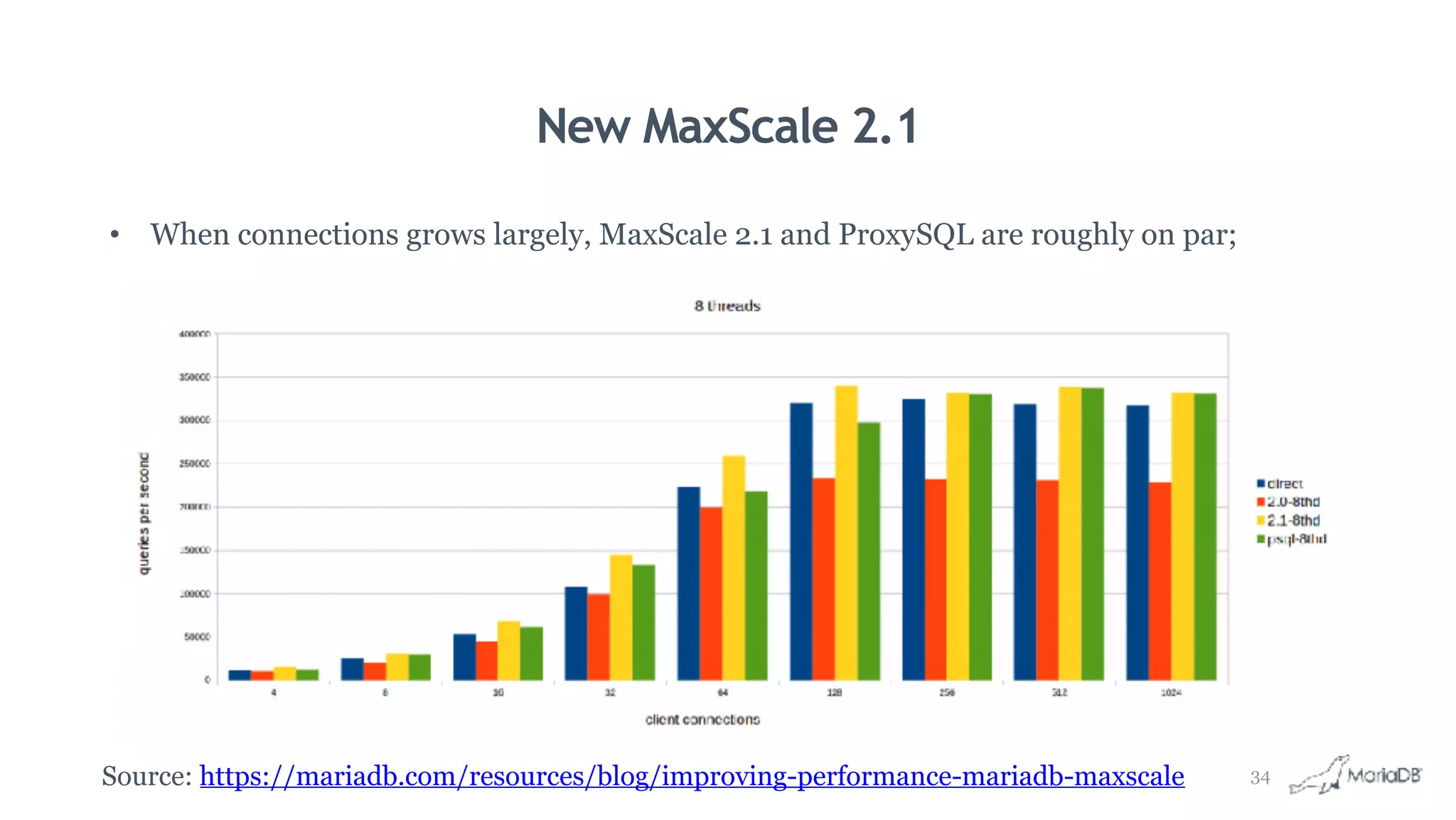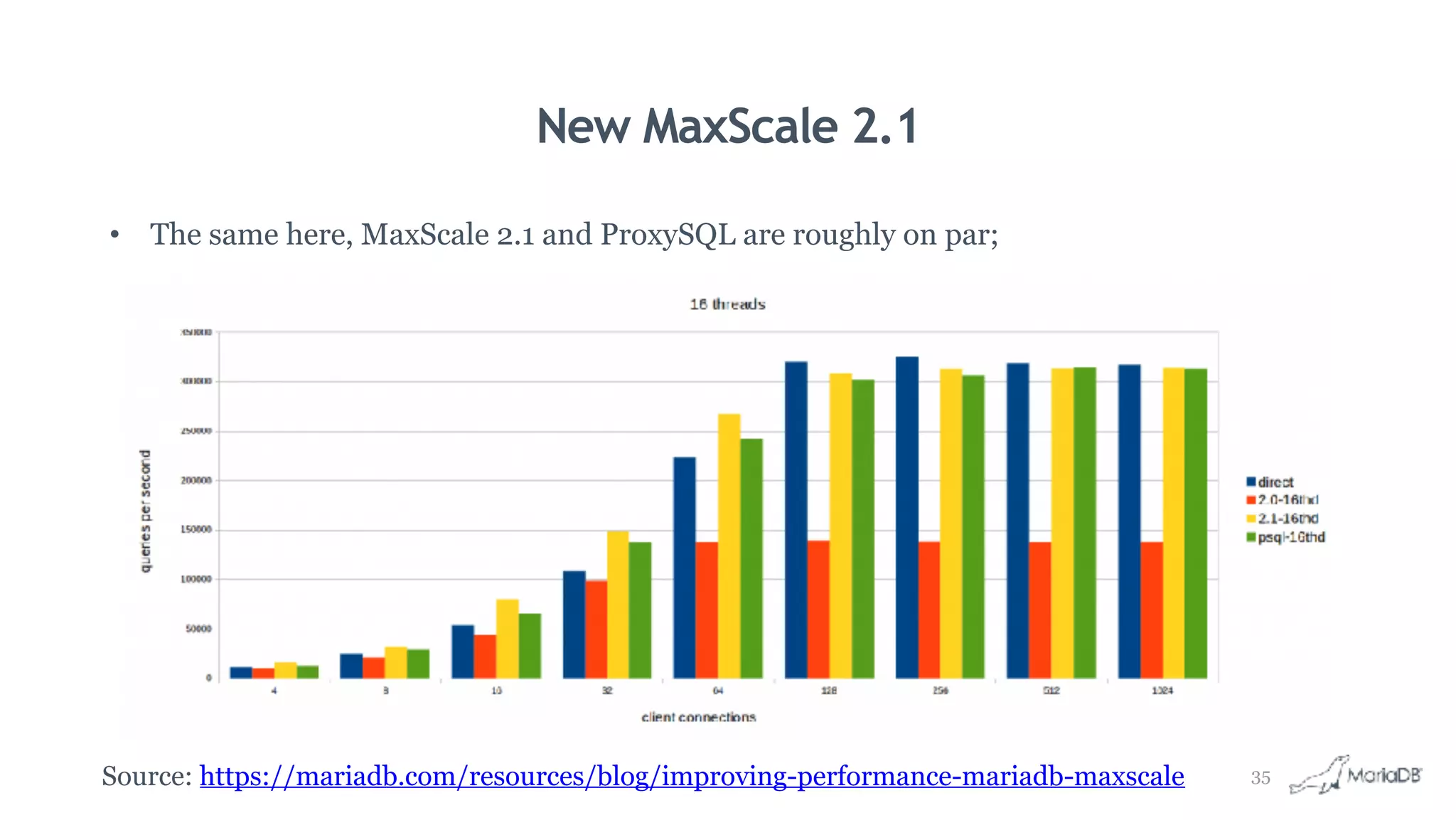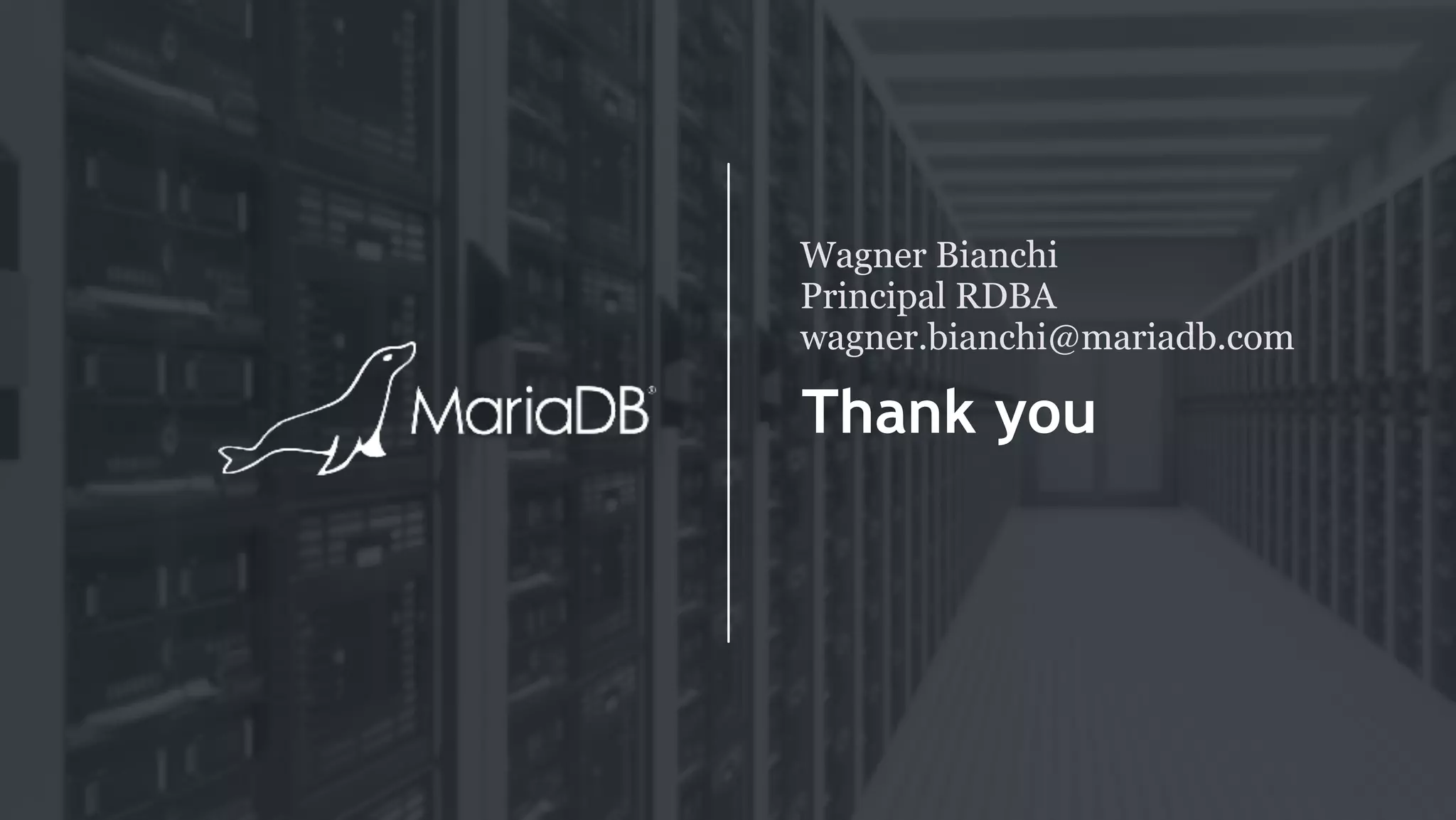This document summarizes information about scaling out MariaDB server and cluster with MaxScale. It discusses the ReadWriteSplit and ConnectionRoute routers for scaling out a MariaDB server replication topology. It also discusses using the Galera Monitor and ReadWriteSplit modules to scale out a MariaDB Cluster deployment with MaxScale. Configurations are provided for using these routers and monitors with MaxScale.
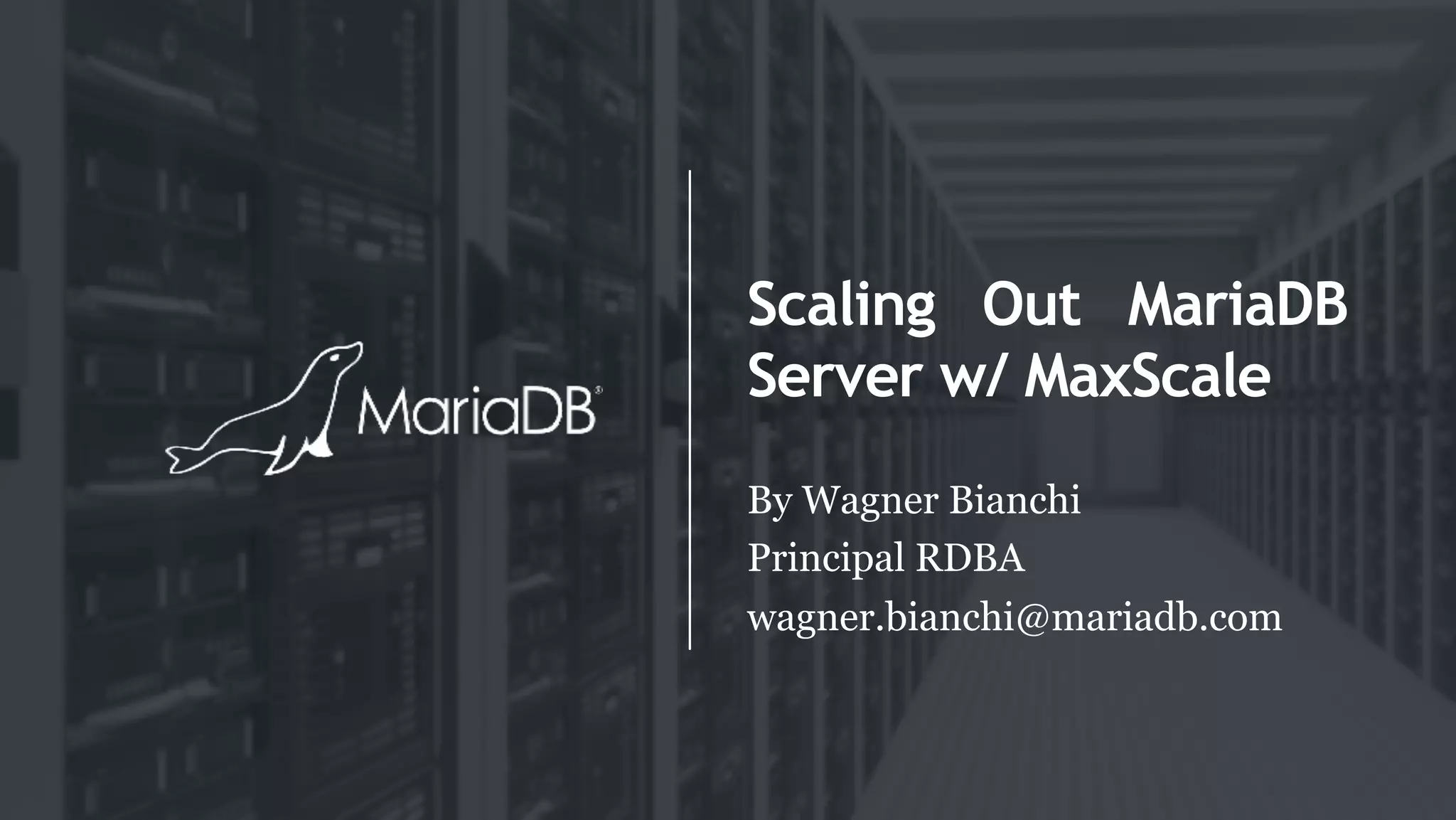


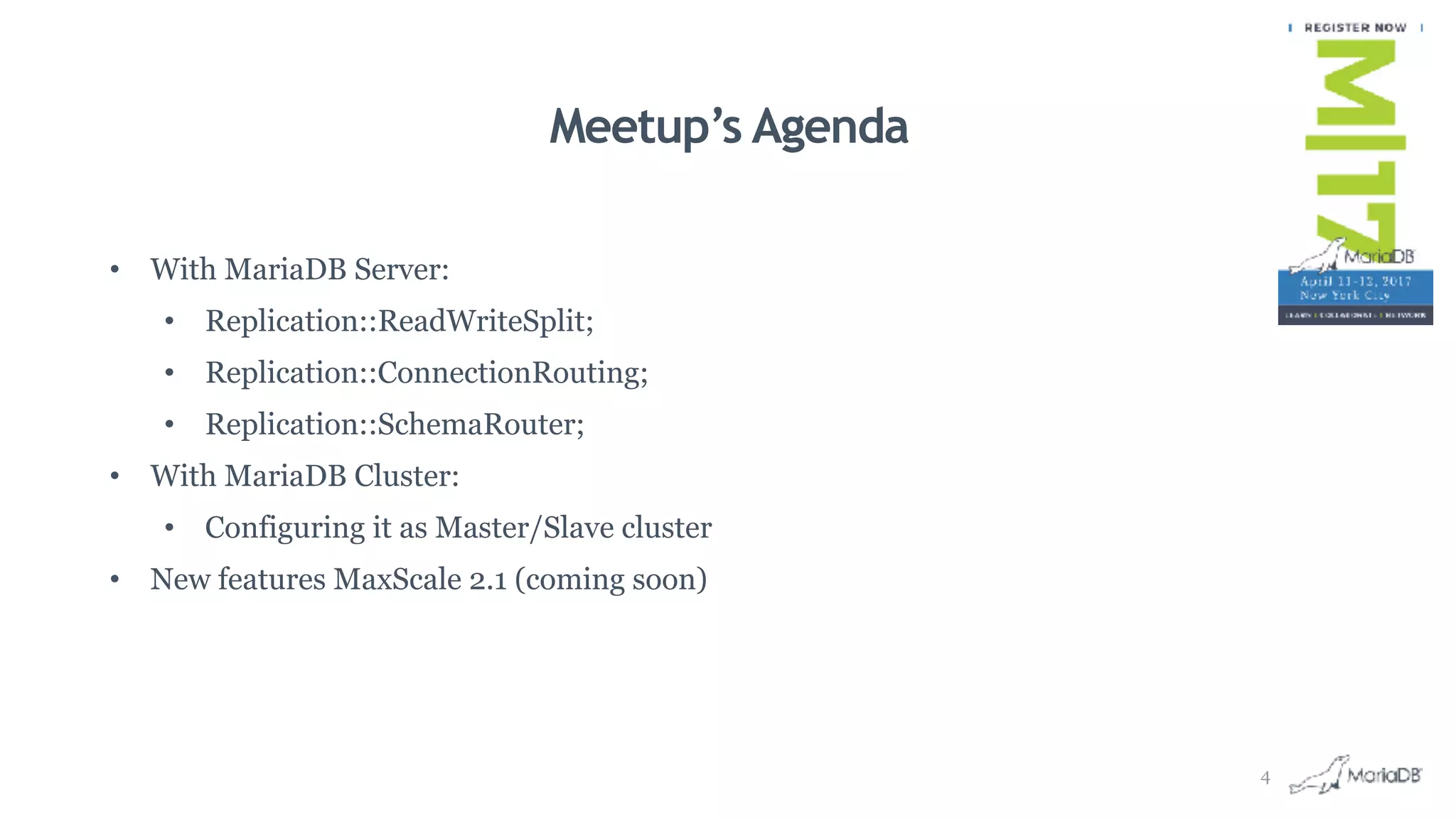
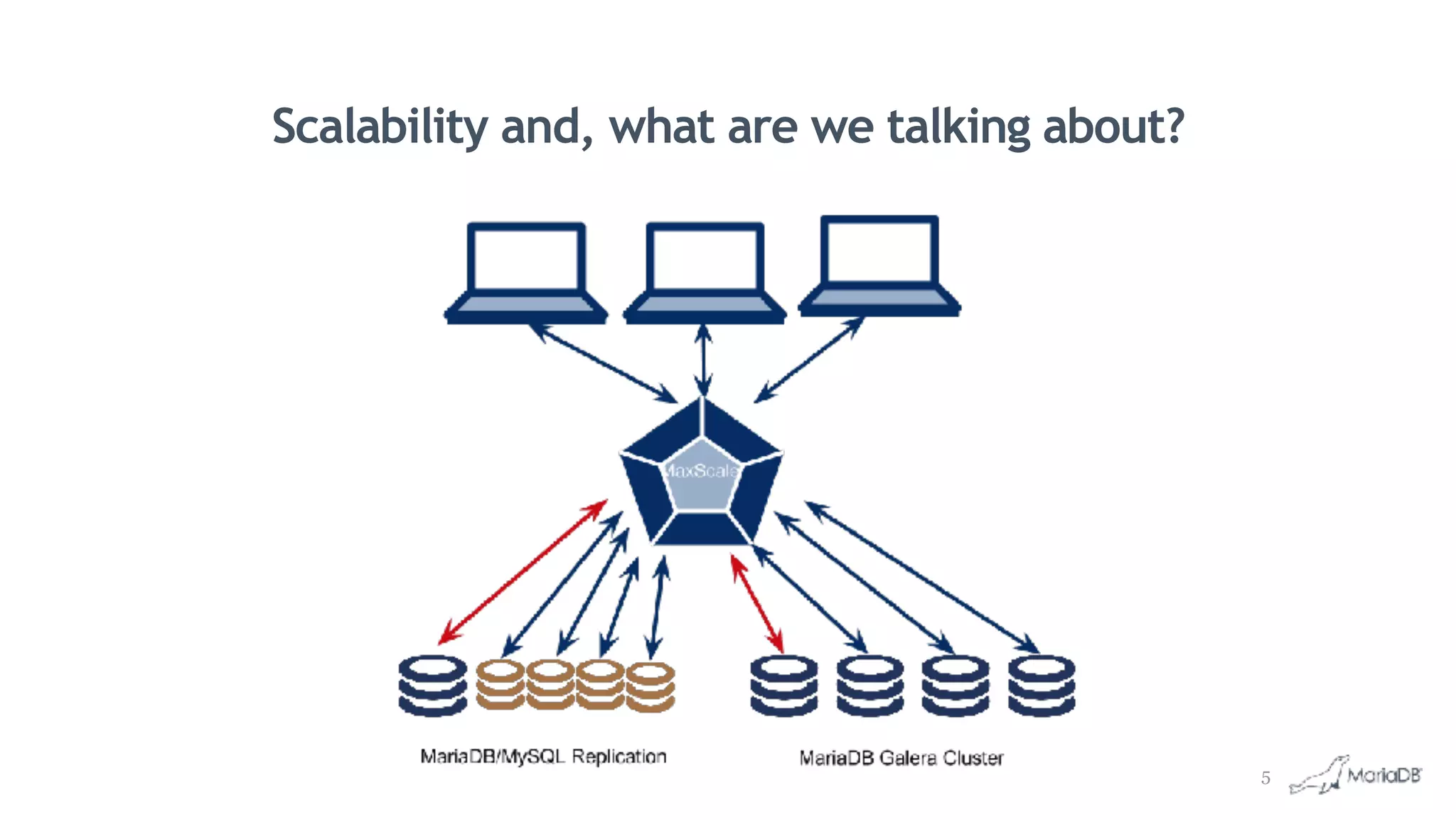

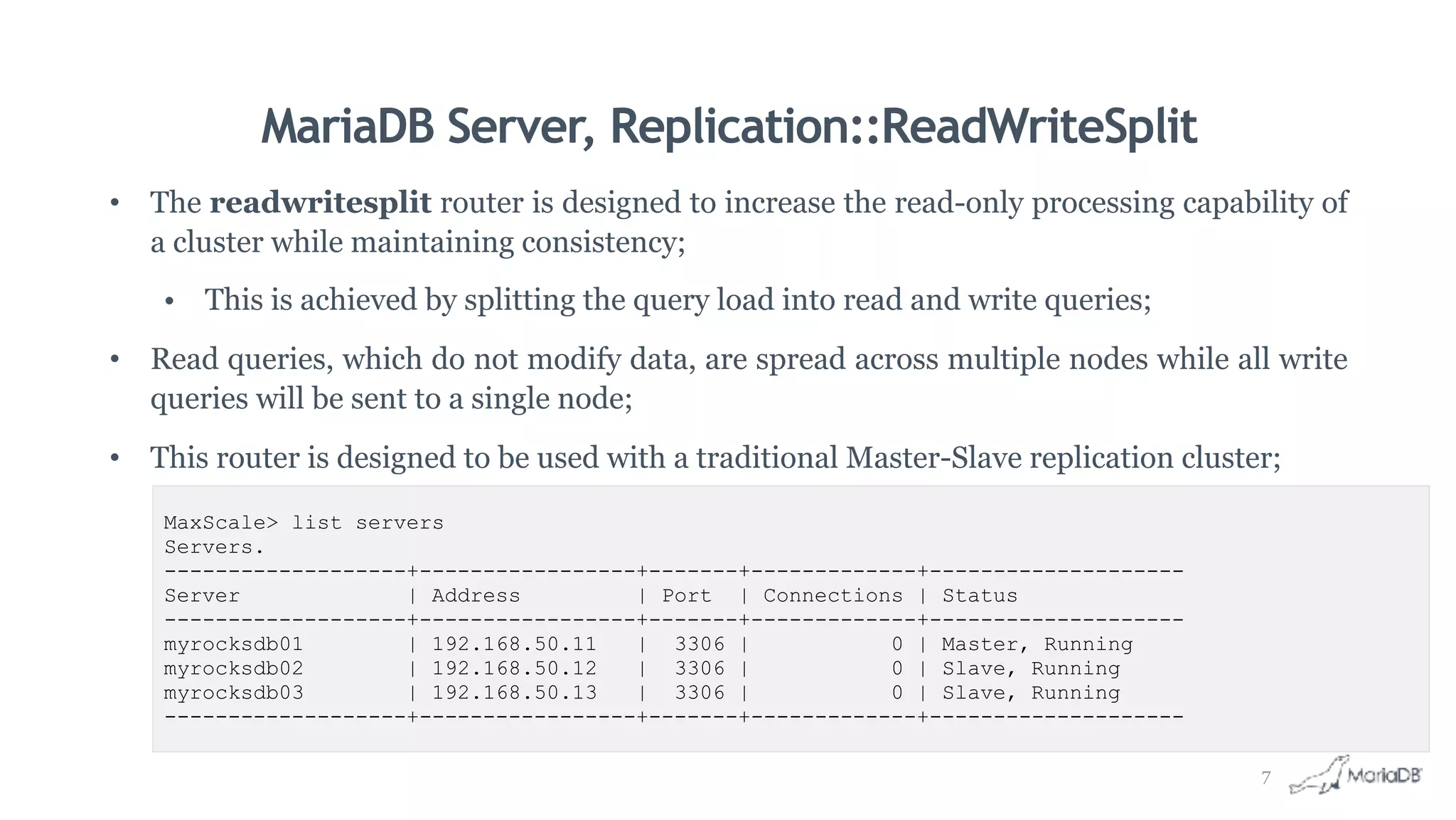
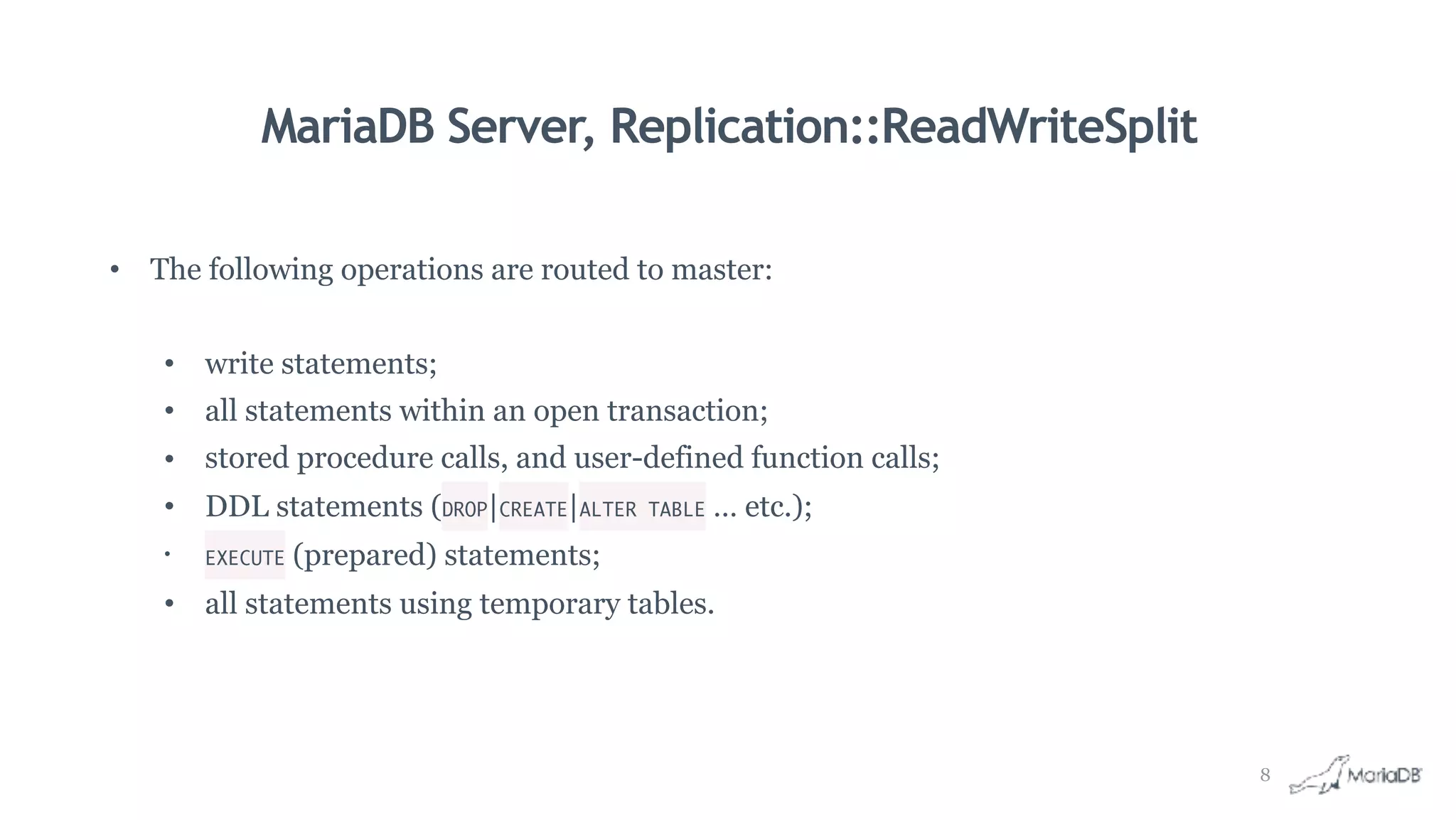
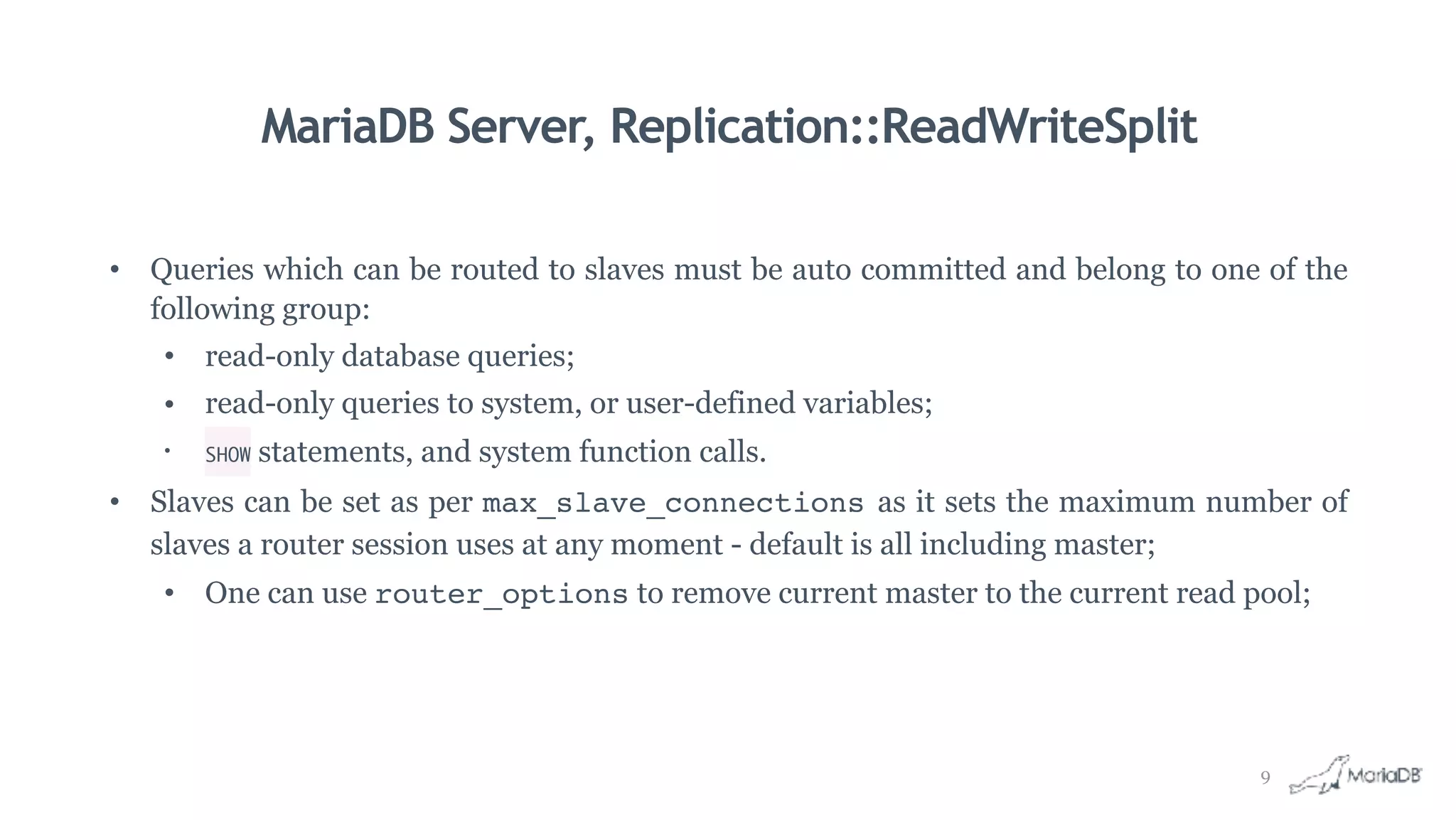
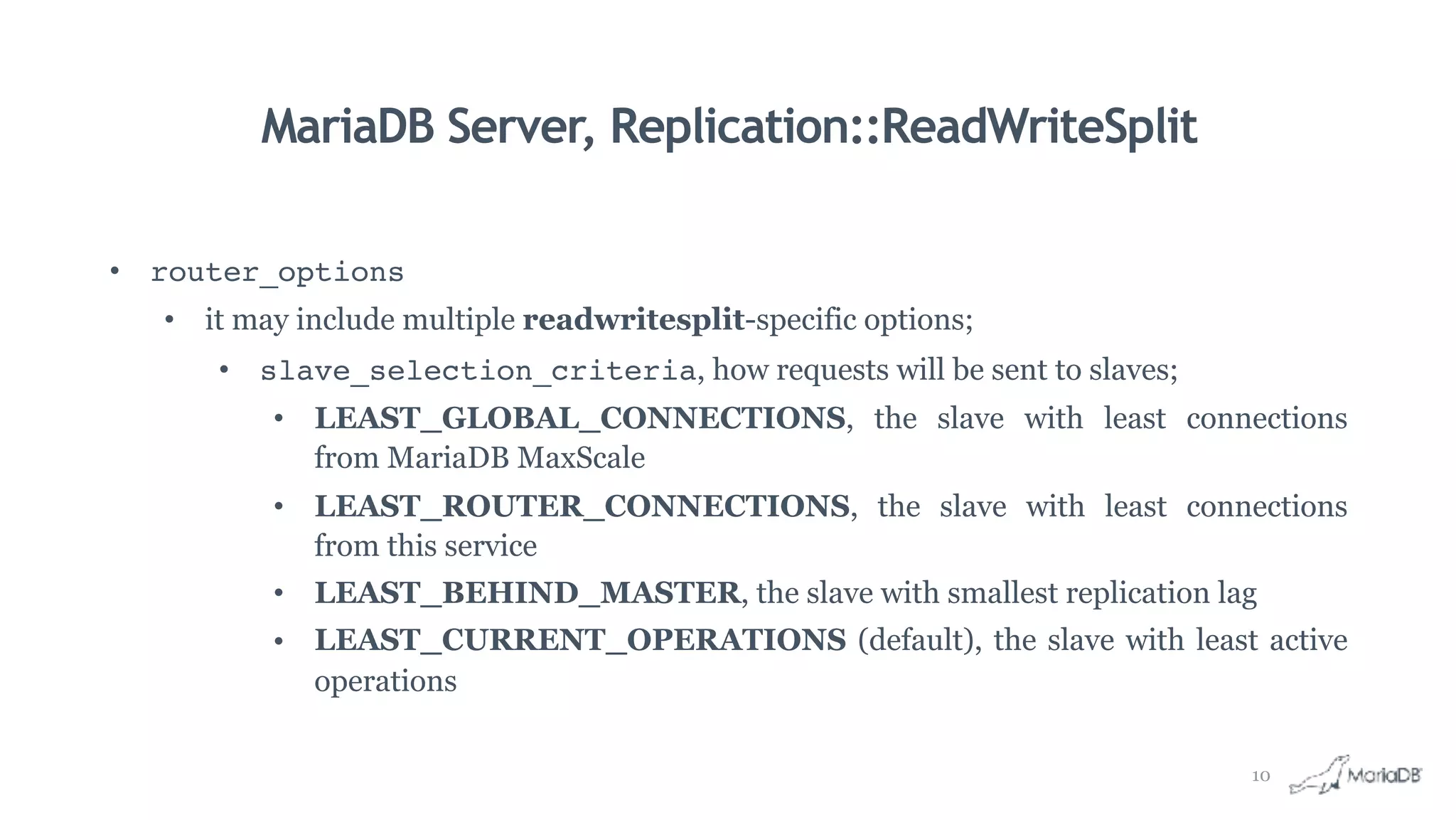
![MariaDB Server, Replication::ReadWriteSplit
• router_options
• master_accept_reads = [true|false]
• the is the option that can include or remove master from the reading pool;
• master_failure_mode
• fail_instantly, when the failure of the master server is detected, the connection
will be closed immediately.
• fail_on_write, the client connection is closed if a write query is received when
no master is available.
• error_on_write, If no master is available and a write query is received, an
error is returned stating that the connection is in read-only mode.
11](https://image.slidesharecdn.com/meetupscalingmariadbwithmaxscale-170504182757/75/NY-Meetup-Scaling-MariaDB-with-Maxscale-11-2048.jpg)
![MariaDB Server, Replication::ReadWriteSplit
[myrocksdb03]
type=server
address=192.168.50.13
port=3306
protocol=MySQLBackend
persistpoolmax=100
persistmaxtime=3600
[CLI]
type=service
router=cli
[CLI Listener]
type=listener
service=CLI
protocol=maxscaled
socket=default
[Splitter Service]
type=service
router=readwritesplit
servers=myrocksdb01,myrocksdb02,myrocksdb03
router_options=slave_selection_criteria=LEAST
_BEHIND_MASTER,master_accept_reads=FALSE,mast
er_failure_mode=erro
r_on_write
max_slave_connections=2
max_slave_replication_lag=30
user=maxuser
passwd=YqztlYG…
[Splitter Listener]
type=listener
service=Splitter Service
protocol=MySQLClient
port=3306
socket=/tmp/myrocksdb_cluster.sock
[Replication Monitor]
type=monitor
module=mysqlmon
servers=myrocksdb01,myrocksdb02,myroc
ksdb03
detect_replication_lag=1
detect_stale_master=1
user=maxuser
passwd=YqztlYG…
[myrocksdb01]
type=server
address=192.168.50.11
port=3306
protocol=MySQLBackend
persistpoolmax=100
persistmaxtime=3600
[myrocksdb02]
type=server
address=192.168.50.12
port=3306
protocol=MySQLBackend
persistpoolmax=100
persistmaxtime=3600
12](https://image.slidesharecdn.com/meetupscalingmariadbwithmaxscale-170504182757/75/NY-Meetup-Scaling-MariaDB-with-Maxscale-12-2048.jpg)
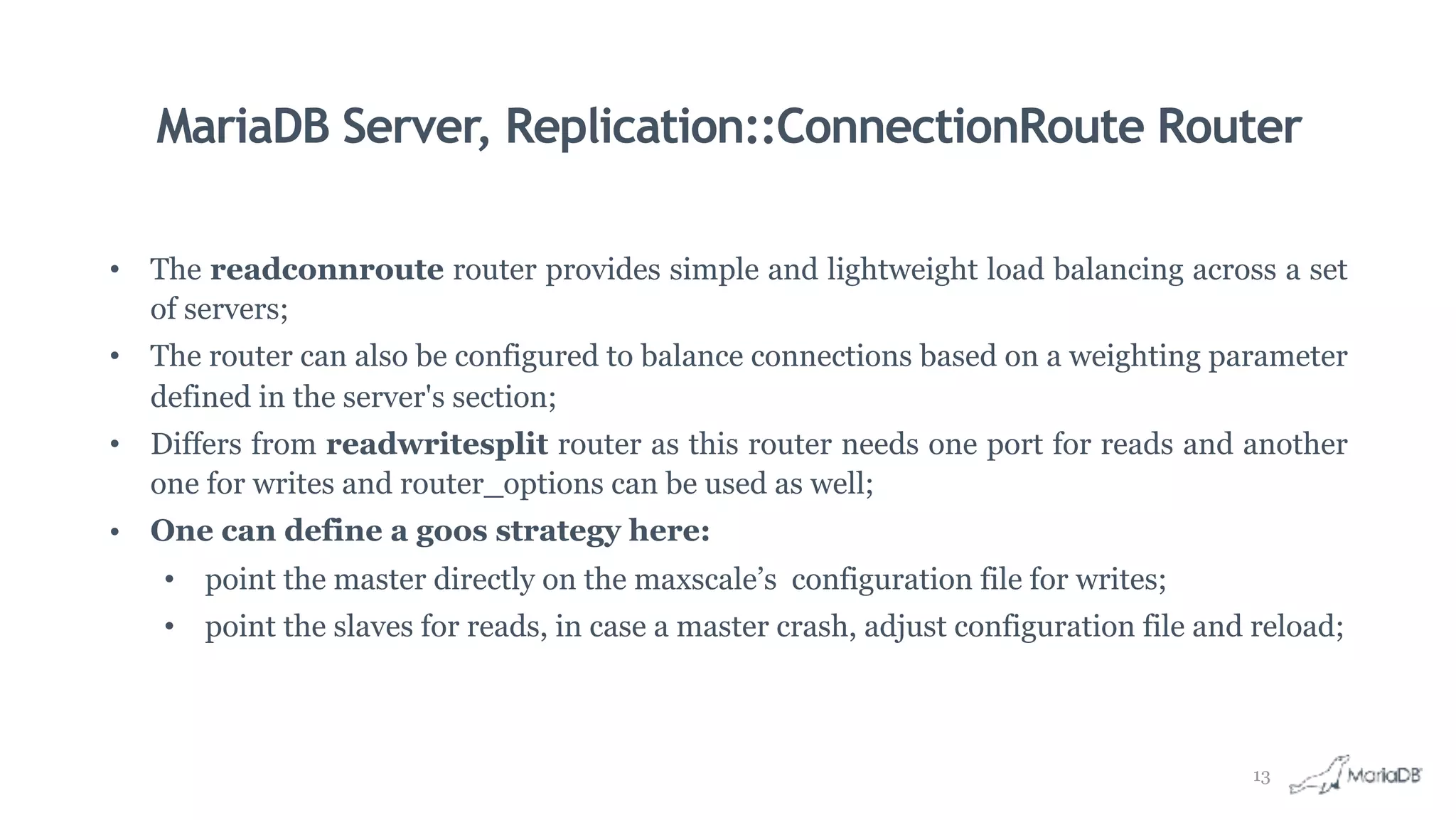
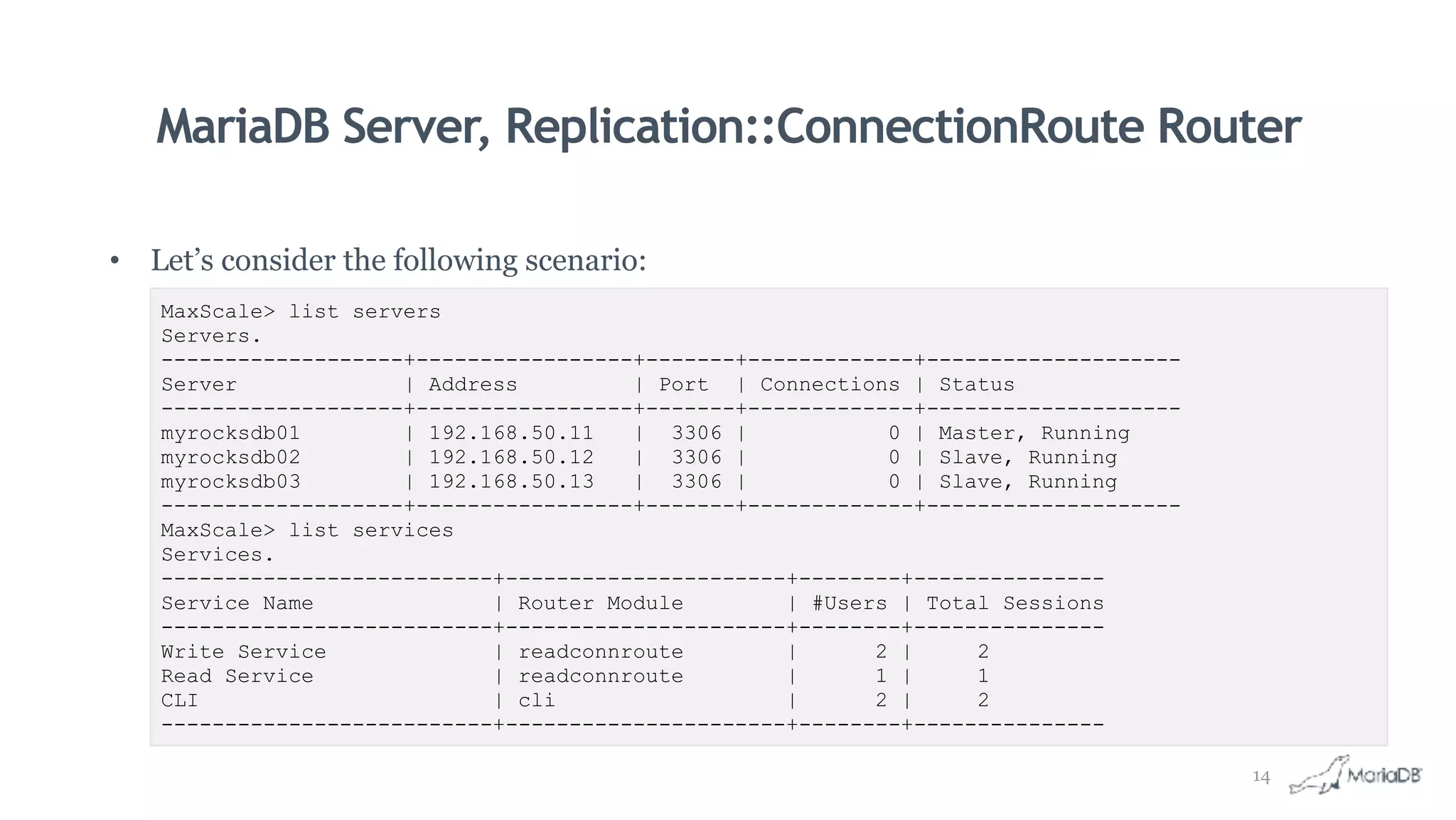
![MariaDB Server, Replication::ConnectionRoute Router
• Let’s shutdown current master:
• We do the manual switch on the MariaDB server:
• reset slave all; on myrocksdb02;
• change master to master_host=‘myrocksdb02’; on myrocksdb03;
• On Maxscale, comment server myrocksdb01, remove it form the list of servers on [Replication
Monitor] and on Write Service, on the latter, put myrocksdb02;
• set server myrocksdb02 master
#: stop/crash current master
[root@box01 ~]# systemctl stop mariadb
#: maxscale logs
Server 192.168.50.11:3306 lost the master status.
Server changed state: myrocksdb01[192.168.50.11:3306]: master_down. [Master, Running] -> [Down]
15](https://image.slidesharecdn.com/meetupscalingmariadbwithmaxscale-170504182757/75/NY-Meetup-Scaling-MariaDB-with-Maxscale-15-2048.jpg)
![MariaDB Server, Replication::ConnectionRoute Router
• After these…
#: new scenario
[root@maxscale maxscale_config]# maxadmin -e "list servers"
Servers.
-------------------+-----------------+-------+-------------+--------------------
Server | Address | Port | Connections | Status
-------------------+-----------------+-------+-------------+--------------------
myrocksdb01 | 192.168.50.11 | 3306 | 0 | Down
myrocksdb02 | 192.168.50.12 | 3306 | 0 | Master, Running
myrocksdb03 | 192.168.50.13 | 3306 | 0 | Slave, Running
-------------------+-----------------+-------+-------------+--------------------
#: maxscale logs
Update server protocol for server 192.168.50.13 to protocol MySQLBackend.
Update server protocol for server 192.168.50.12 to protocol MySQLBackend.
Update router for service Read Service to readconnroute.
Update router for service Write Service to readconnroute.
Server changed state: myrocksdb02[192.168.50.12:3306]: new_slave. [Master, Slave, Running] ->
[Slave, Running]
16](https://image.slidesharecdn.com/meetupscalingmariadbwithmaxscale-170504182757/75/NY-Meetup-Scaling-MariaDB-with-Maxscale-16-2048.jpg)
![MariaDB Server, Replication::ConnectionRoute Router
• Configuration for readconnroute load balancer
[Write Service]
type=service
router=readconnroute
router_options=master
servers=myrocksdb01
user=maxuser
password=123456
[Read Service]
type=service
router=readconnroute
router_options=slave
servers=myrocksdb02,myrocksdb03
weightby=serv_weight
user=maxuser
password=123456
[Write Listener]
type=listener
service=Write Service
protocol=MySQLClient
port=33066
socket=/tmp/myrocksdb_readconnroute.sock
[Read Listener]
type=listener
service=Read Service
protocol=MySQLClient
port=33077
[myrocksdb01]
type=server
address=192.168.50.11
port=3306
protocol=MySQLBackend
[myrocksdb02]
type=server
address=192.168.50.12
port=3306
protocol=MySQLBackend
serv_weight=3
[myrocksdb03]
type=server
address=192.168.50.13
port=3306
protocol=MySQLBackend
serv_weight=2 17](https://image.slidesharecdn.com/meetupscalingmariadbwithmaxscale-170504182757/75/NY-Meetup-Scaling-MariaDB-with-Maxscale-17-2048.jpg)

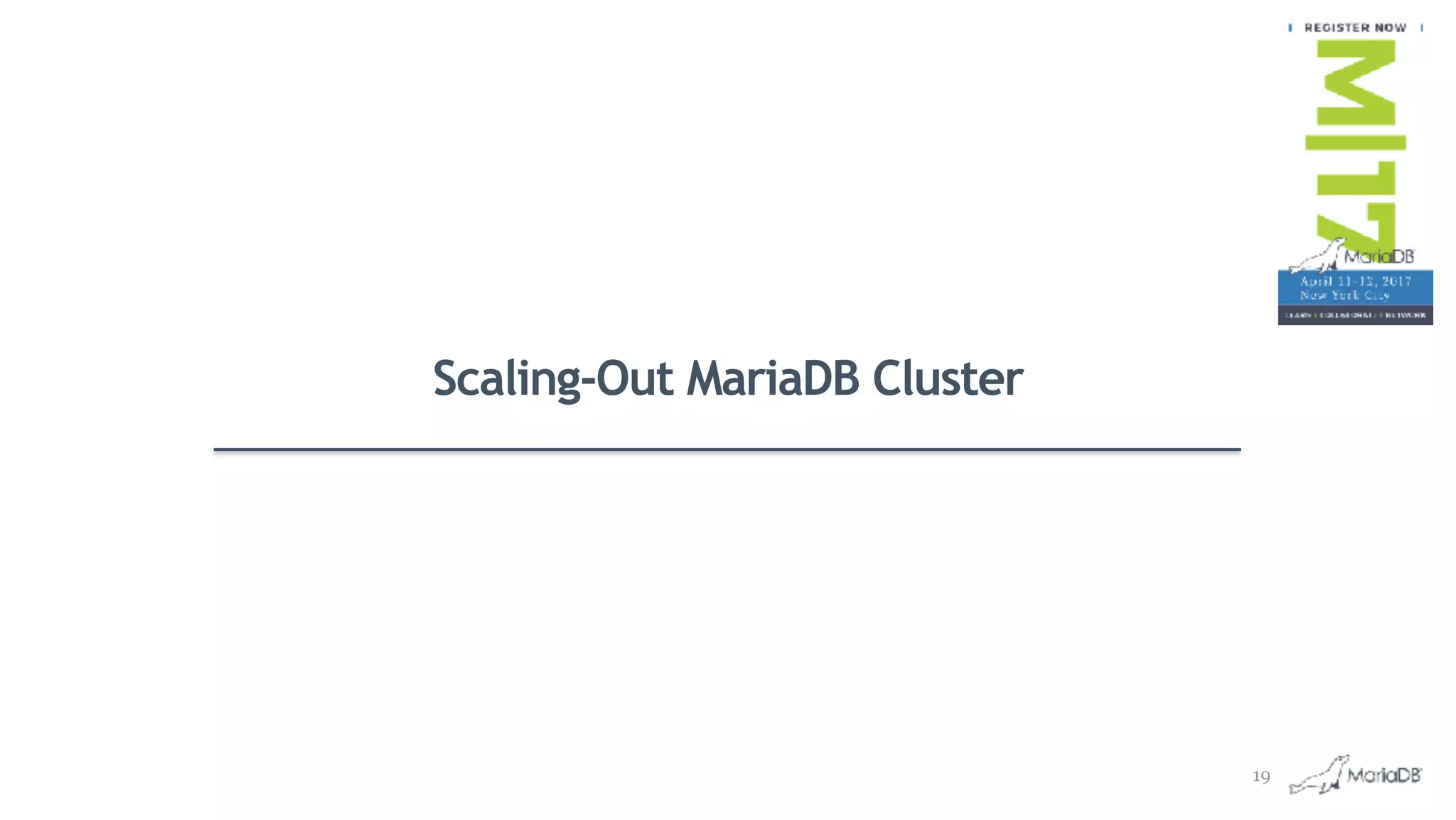

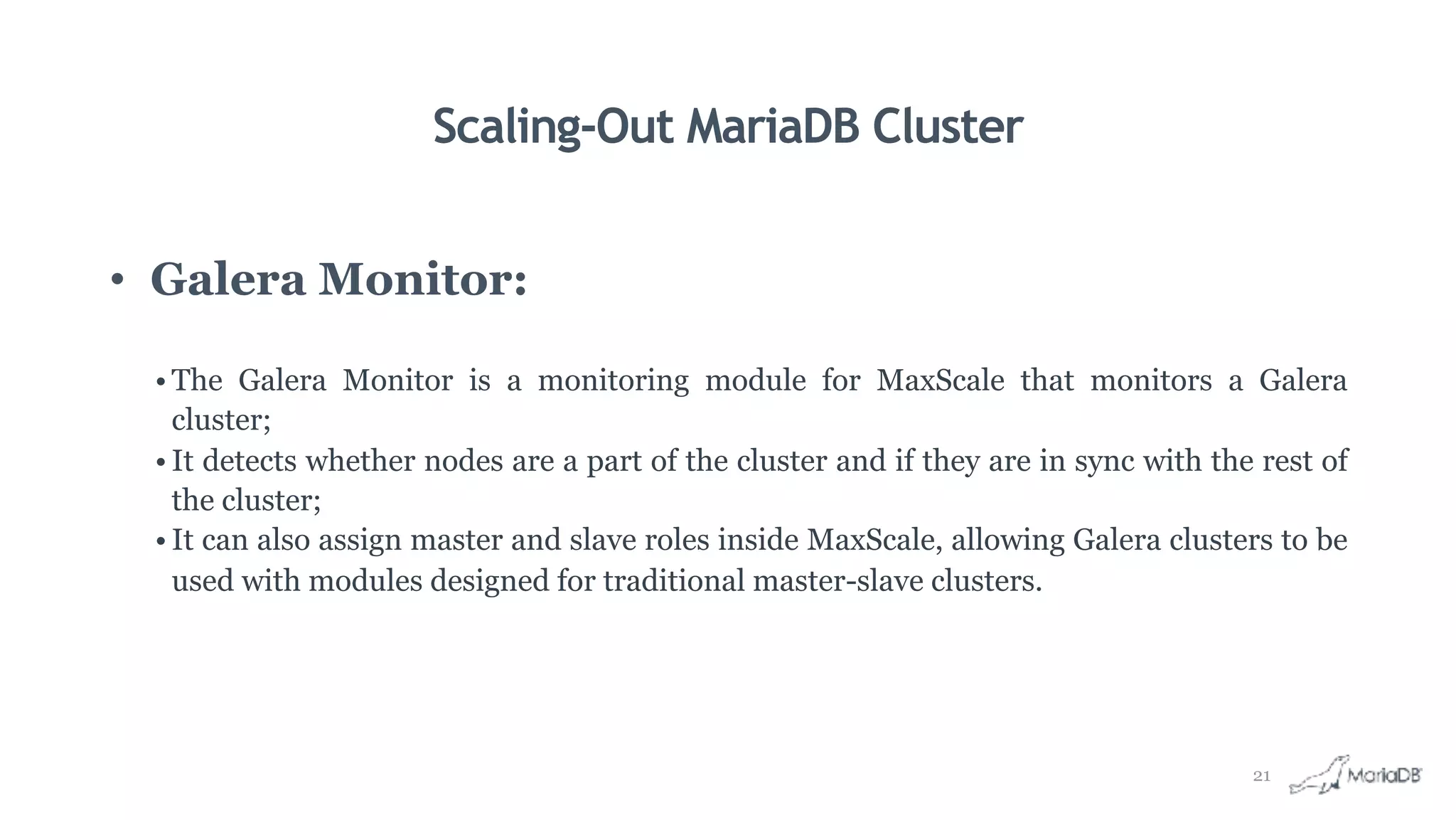
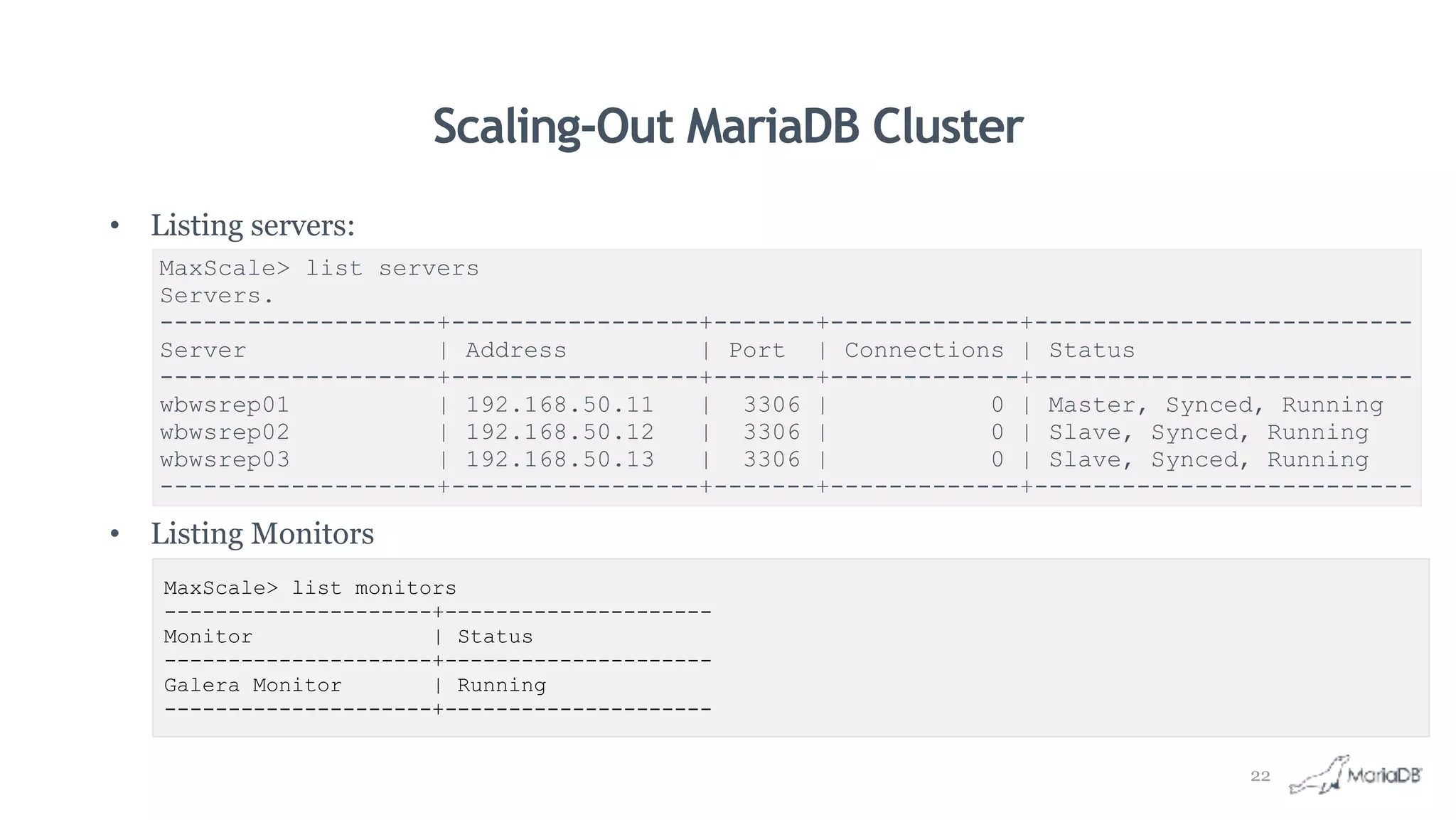
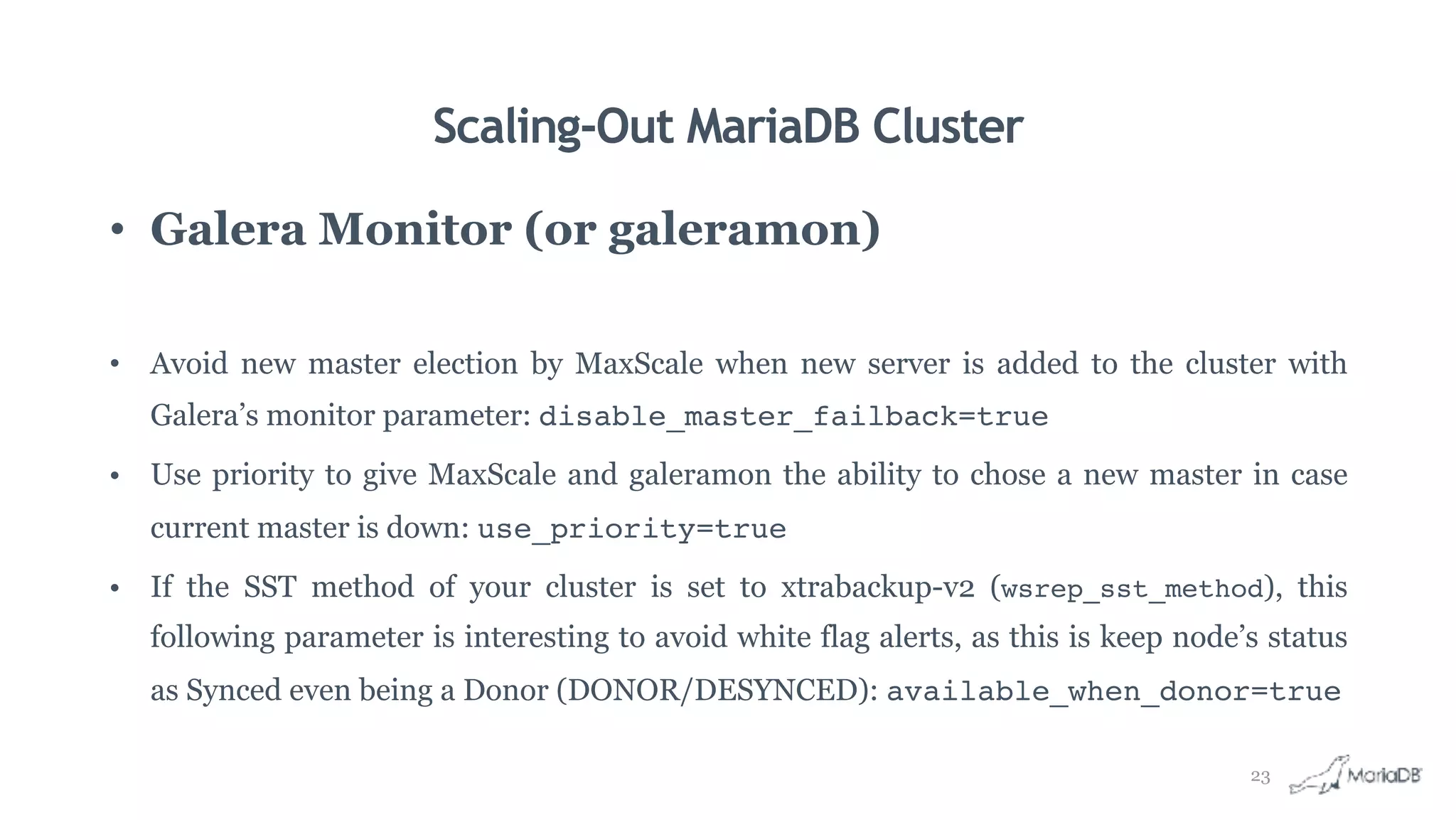
![Scaling-Out MariaDB Cluster
• When using priorities to elect current master:
[root@maxscale ~]# maxadmin -e "list servers"
Servers.
-------------------+-----------------+-------+-------------+--------------------
Server | Address | Port | Connections | Status
-------------------+-----------------+-------+-------------+--------------------
wbwsrep01 | 192.168.50.11 | 3306 | 654 | Master, Synced, Running
wbwsrep02 | 192.168.50.12 | 3306 | 76 | Slave, Synced, Running
wbwsrep03 | 192.168.50.13 | 3306 | 89 | Slave, Synced, Running
-------------------+-----------------+-------+-------------+--------------------
[root@maxscale ~]# vim /etc/maxscale.cnf # edited priorities
[root@maxscale ~]# systemctl restart maxscale
[root@maxscale ~]# maxadmin -e "list servers"
Servers.
-------------------+-----------------+-------+-------------+--------------------
Server | Address | Port | Connections | Status
-------------------+-----------------+-------+-------------+--------------------
wbwsrep01 | 192.168.50.11 | 3306 | 78 | Slave, Synced, Running
wbwsrep02 | 192.168.50.12 | 3306 | 3 | Slave, Synced, Running
wbwsrep03 | 192.168.50.13 | 3306 | 12 | Master, Synced, Running
-------------------+-----------------+-------+-------------+--------------------
24](https://image.slidesharecdn.com/meetupscalingmariadbwithmaxscale-170504182757/75/NY-Meetup-Scaling-MariaDB-with-Maxscale-24-2048.jpg)
![Scaling-Out MariaDB Cluster
• When using priorities to elect current master:
#: monitor section
[Galera Monitor]
type=monitor
module=galeramon
servers=wbwsrep01,wbwsrep02,wbwsrep03
disable_master_failback=true
available_when_donor=true
use_priority=true
user=maxmon
passwd=123
#: servers section
[wbwsrep01]
type=server
address=192.168.50.11
port=3306
protocol=MySQLBackend
priority=3
[wbwsrep02]
type=server
address=192.168.50.12
port=3306
protocol=MySQLBackend
priority=2
[wbwsrep03]
type=server
address=192.168.50.13
port=3306
protocol=MySQLBackend
priority=1
25](https://image.slidesharecdn.com/meetupscalingmariadbwithmaxscale-170504182757/75/NY-Meetup-Scaling-MariaDB-with-Maxscale-25-2048.jpg)
![Scaling-Out MariaDB Cluster
• In case you need to execute a current master’s restart:
#: stop current master
[root@box03 ~]# systemctl stop mariadb
#: set current master in maintenance
MaxScale> list servers
Servers.
-------------------+-----------------+-------+-------------+--------------------
Server | Address | Port | Connections | Status
-------------------+-----------------+-------+-------------+--------------------
wbwsrep01 | 192.168.50.11 | 3306 | 72 | Slave, Synced, Running
wbwsrep02 | 192.168.50.12 | 3306 | 327 | Master, Synced, Running
wbwsrep03 | 192.168.50.13 | 3306 | 0 | Maintenance, Down
—————————+-----------------+-------+-------------+--------------------
#: new master elected (checking logs - /var/log/maxscale/maxscale1.log)
Server changed state: wbwsrep02[192.168.50.12:3306]: new_master. [Slave, Synced, Running] ->
[Master, Synced, Running]
Server changed state: wbwsrep03[192.168.50.13:3306]: master_down. [Master, Synced, Running] ->
[Down]
26](https://image.slidesharecdn.com/meetupscalingmariadbwithmaxscale-170504182757/75/NY-Meetup-Scaling-MariaDB-with-Maxscale-26-2048.jpg)
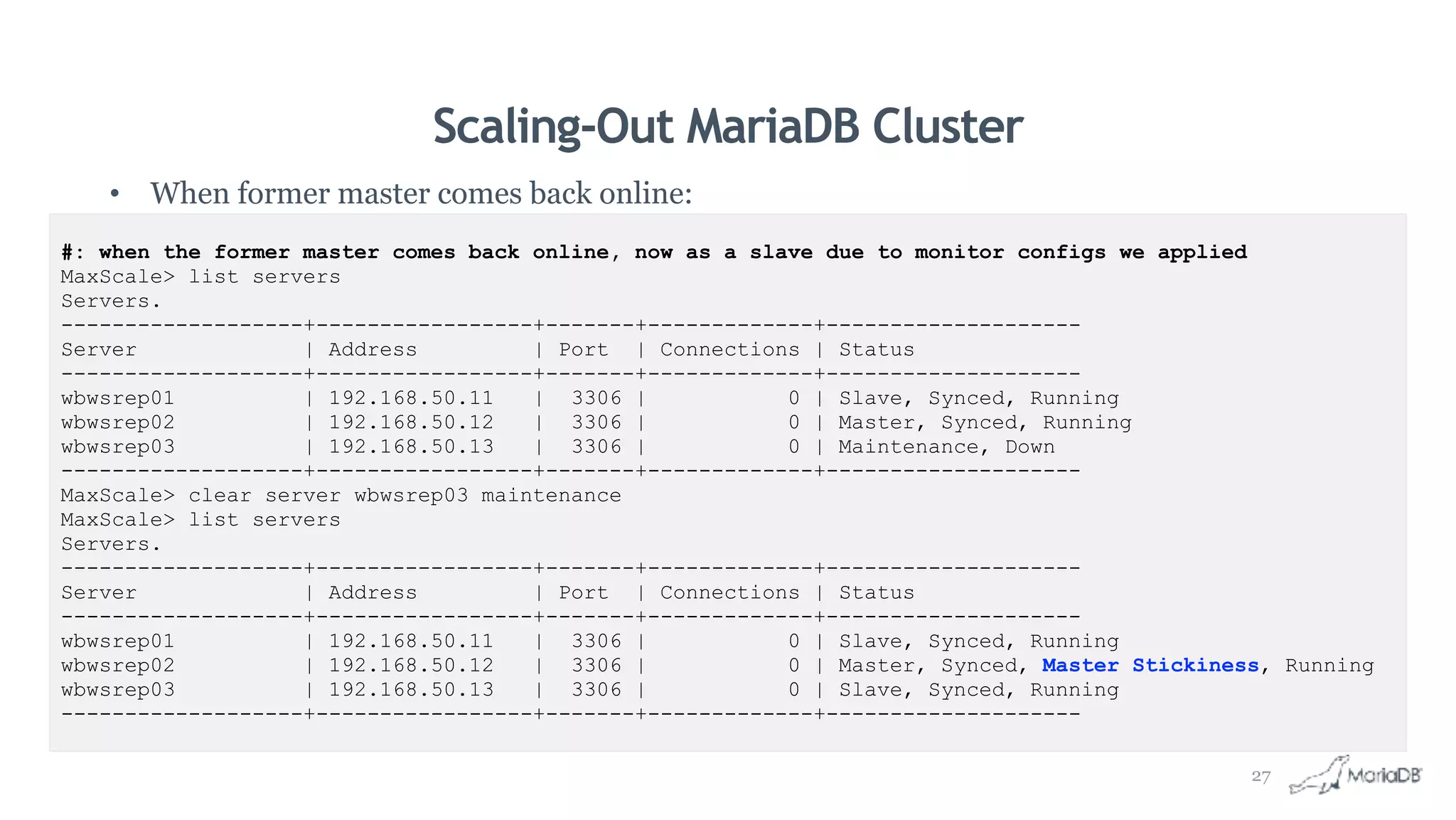
![Scaling-Out MariaDB Cluster
• Adding a new galera cluster's node:
• Provision a new node on cluster level and go for the proper settings;
• Raise the new node and make sure it’s part of the PRIMARY component;
• Make sure the new node is in Sync status:
• On MaxScale 2.0 config file:
• Make sure you add the new [servername] entry on servers definition;
• Make sure the Galera Service and the Galera Monitor lists the the servers name;
• Use maxadmin -e “reload configs"
#: tailing the log file after configurations and restart
Server changed state: wbwsrep01[192.168.50.11:3306]: new_slave. [Running] -> [Slave, Synced, Running]
Server changed state: wbwsrep02[192.168.50.12:3306]: new_slave. [Running] -> [Slave, Synced, Running]
Server changed state: wbwsrep03[192.168.50.13:3306]: new_master. [Running] -> [Master, Synced, Running]
Server changed state: wbwsrep04[192.168.50.14:3306]: new_slave. [Running] -> [Slave, Synced, Running]
28](https://image.slidesharecdn.com/meetupscalingmariadbwithmaxscale-170504182757/75/NY-Meetup-Scaling-MariaDB-with-Maxscale-28-2048.jpg)
![Scaling-Out MariaDB Cluster
• The new scenario we have by now:
#: listing servers again, with the new added one
[root@maxscale ~]# maxadmin -e "list servers"
Servers.
-------------------+-----------------+-------+-------------+--------------------
Server | Address | Port | Connections | Status
-------------------+-----------------+-------+-------------+--------------------
wbwsrep01 | 192.168.50.11 | 3306 | 0 | Slave, Synced, Running
wbwsrep02 | 192.168.50.12 | 3306 | 0 | Slave, Synced, Running
wbwsrep03 | 192.168.50.13 | 3306 | 0 | Master, Synced, Running
wbwsrep04 | 192.168.50.14 | 3306 | 0 | Slave, Synced, Running
-------------------+-----------------+-------+-------------+--------------------
29](https://image.slidesharecdn.com/meetupscalingmariadbwithmaxscale-170504182757/75/NY-Meetup-Scaling-MariaDB-with-Maxscale-29-2048.jpg)
